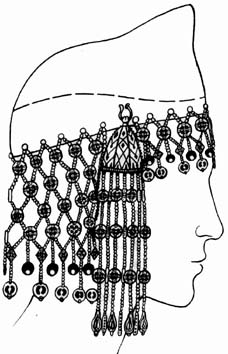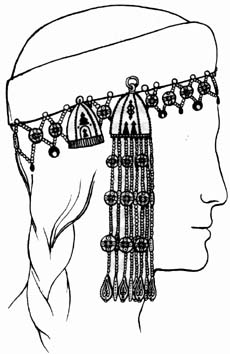Podniza
Boiarynia Katrusha the Skomorokh
The
joy of a Russian persona is that all women's clothing was, more or
less, exactly the same differing slightly in fabrics but mostly in
trims and ornamentation. One of the most popular ingredients of
ornamentation were pearls. Pearls could be used in many ways, from
sewing them directly on to an outfit or couching them on with
embroidery. Because pearls were such an easy thing to find all over
Russia, it is not surprising that many women would create podniza,
veils attached to their hats that would hang about to their eyebrows,
as forms of decoration. It could take hundreds of pearls, depending
on how tight knit you wanted your network to be. Because of the
amount of work it takes to make one of these, it was not strange to
find them passed down from mother to daughter and re-attached to
hats. The first time they may be seen is on the crown like hat that
is placed on a woman's head when she gets married.
Hats, in general, were a part of Russian culture that
could designate your status. Depending on the style of hat, types of
decoration, it could easily be seen whether you were married or a
maiden and what role you played in society. A kokoshnik, for example,
was a crown like hat. Usually the ladies of high society liked to
keep their kokoshnik smaller, more crown like, while the towns women
inflated them to much larger sizes. It is no wonder, with the hats so
large and ornamental, that the hundreds of pearls could be seen as a
stabilizer for the hat.
There were a few key points usually found on hats.
First were the riasny. These had started in history as a Byzantine
accessory and usually was only seen in court headdresses. They were
normally ten to twelve inch long strings of pearls that dangled
coins, or kolti, at the bottom for the sound. These riasny were
attached to the hat rim directly over ones ears. Later, the riasny
became more decorative, using strips of gold fabric that would then
be heavily ornamented with pearls and jewels, but kept the same
length as before.
12th - 14th century Russian headdress adornments
Photo courtesy of Secret Chamber of Kremlin
http://textplay.net/pages/0015.htm
12th - 14th century Russian headdress adornments
Photo courtesy of Secret Chamber of Kremlin
http://textplay.net/pages/0015.htm
The second aspect of the hat was the ubrus, a scarf
that would be folded in half and either draped or attached to the
back of the hat. It would then sometimes be pinned about under the
chin of the wearer, or it could be left hanging down the back. Either
way, it was said that some ubrus were decorated just as heavily with
pearl trimmings and metalic embroidery.
The third aspect of the hat, finding a counter balance
all the way around, was the podniza. The podniza first appeared in
the Muscovite period of Russia, and it was an open lace work
structure that formed a decoration on the front of the headdress. The
net of small pearls usually attached to the front of the headdress
and stretched from ear to ear where the riasny hung, covering fully
over the forehead and hanging nearly to the eyebrows. This acted in a
manner to not only stabilize the hat, but also fashionably extend the
hat band.
Podniza are created by making small loops of pearls
where each row attaches to the middle of the loop on the row above
it. Not all podniza encorporated only pearls, though. Nor did they
all only stretch the front of the hat. There have been finds of the
podniza having fine metals or jewels being encircled by the pearls or
even dangling, much like the riasny, to make soft sounds when the
wearer moved. This could perhaps be attributed to the fact that noise
was seen as a way to banish evil spirits in your path. There have
been finds of the podniza being sewn onto fabric, as well, much like
the riasny that came later. There have also been finds of a longer
veil like podniza attached to the back of the hat instead of an
ubrus.
In either case, podniza was a fashionable item to put
on the headdress that also helped to weigh it down, with the help of
the riasny and the ubrus, to keep the large ornamental hats from
tumbling off the head. I have made two podniza, the
first being made from glass pearls (which was not uncommon for a
peasant to use). The second one was made of small irregular shaped pearls
as I am certain that not all pearls found in the streams of Russia
had been perfectly shaped. I started with a straight line of pearls
before starting the looping network in a horizontal manner. I have
heard doing it vertically makes it a little stronger and gives it
more elasticity, so I may try that next time. I also plan to add in the metal discs or pearl flowers to the next podniza.
Fig 1
Fig 2
Fig 3
Some different examples of podniza:
Fig 1: The podniza appears to be sewn onto a band going
around the hat and appears to interchange between pearls and metal
discs.
Fig 2: Another example of a podniza interchanging
between pearls, discs of metal, and jewels. This is also a great
example of a podniza extending all the way around to create an almost
veil behind the head. This is also a headdress of a married woman.
Fig 3: Here is a maiden's headdress with a much shorter
podniza than the married woman's headdress, but it still goes all the
way around the back of the head.
All drawings copyright Julia Sepanova.
References
Kies,
Lisa. Women's Headdress in Early Rus.
http://shadow-cat.150m.com/Costume/rusheads.html
(April 3rd,
2011).
Pouncy, Carolyn Johnston. The Domostroi: Rules For
Russian Households in the Times Of Ivan the Terrible. Cornell
University Press: London. 1994.
Pushkareva, Natalia. Women in Russian History: From
the Tenth to the Twentieth Century. M. E. Sharpe: Armanok, NY.
1997.
Rostovskogo, MordakTimofei. Class Notes “The Practical
Clotheshorse Embroidered: 16th Century Russian Decorative
Stitchery and Pearling.” 1997.
Sepanov, Julia.
History of the Russian Traditional Suit.
http://archcostume.narod.ru/index.htm
(February-April 2011).







No comments:
Post a Comment